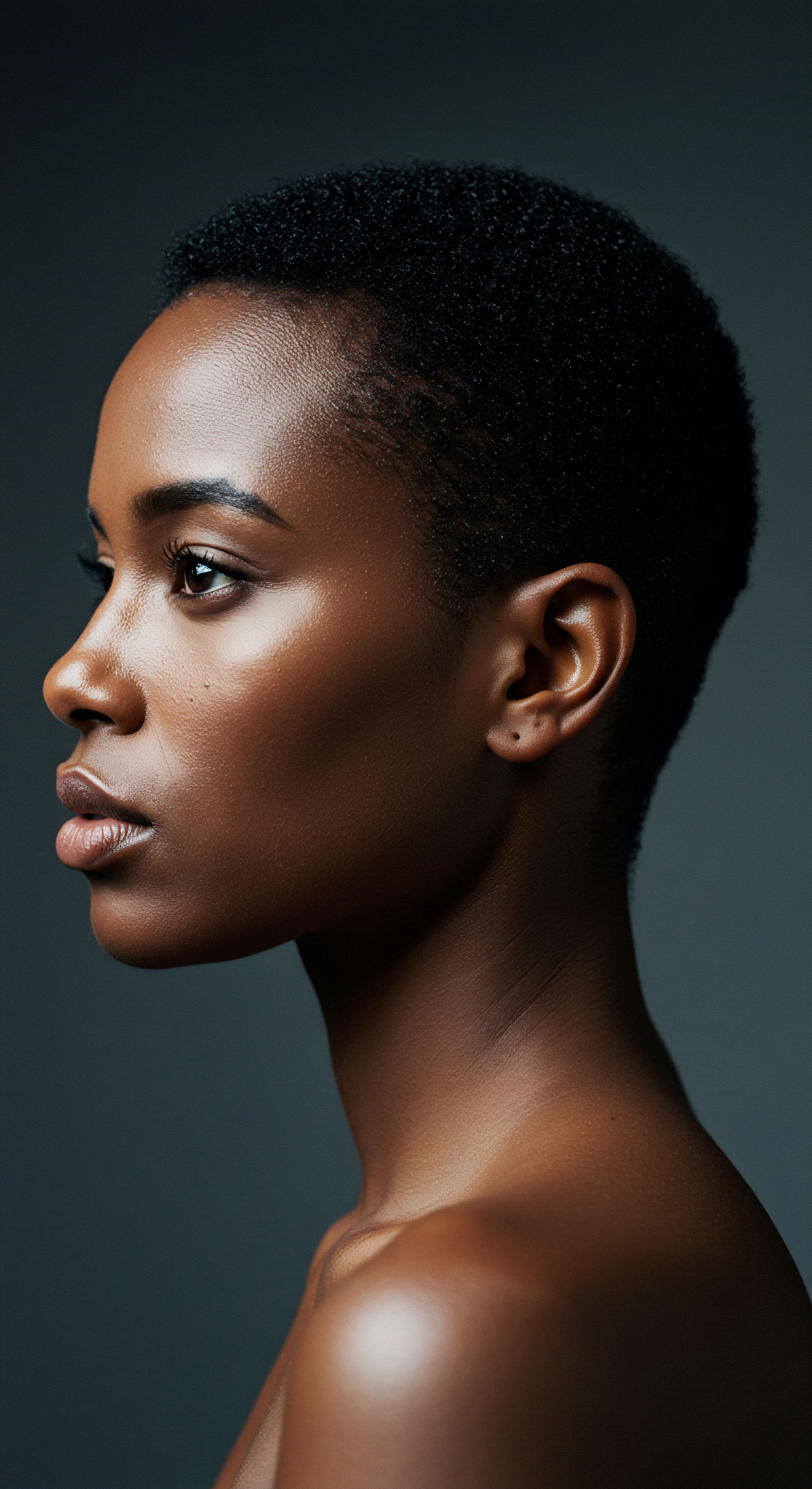
Roots
The whisper of the wind through the leaves, the rhythmic ebb and flow of the tides – nature’s gentle insistence on cycles finds its echo within us, down to the very strands that crown our heads. Many of us intuitively sense a connection between our inner state and the outward vitality of our hair. We notice the subtle shifts, the way our curls might lose their spirited bounce or our coils appear less robust when life feels demanding.
Among the many factors influencing hair’s living presence, the quietude of deep rest often goes unacknowledged, yet its absence can ripple through our entire being, potentially touching the very density of our textured hair. What secrets do our follicles hold, and how does the nocturnal world influence their delicate rhythm?

The Architecture of a Strand
Each strand of hair, regardless of its unique texture, emerges from a tiny organ nestled beneath the skin ❉ the Hair Follicle. These miniature factories are not static entities; they are dynamic, living structures, constantly engaged in a meticulously timed dance of growth, transition, and rest. Understanding this cycle is foundational to appreciating how external influences, such as sleep patterns, might impact hair density.
- Anagen ❉ This is the active growth phase, a period of vigorous cell division within the follicle. Hair is actively lengthening and strengthening during this time. For textured hair, this phase can last anywhere from two to seven years, shaping the potential for significant length and density.
- Catagen ❉ A brief, transitional phase, lasting only a few weeks. Growth ceases, and the follicle shrinks, preparing for the next stage.
- Telogen ❉ The resting phase, typically lasting a few months. The hair remains in the follicle but is no longer growing. At the end of this phase, the hair is shed, making way for a new anagen hair to emerge from the same follicle.
The collective presence of hair on our scalp, what we perceive as density, is a reflection of how many follicles are actively in the anagen phase at any given moment. A healthy scalp typically has 85-90% of its hair in the anagen phase. When this delicate balance is disturbed, more hairs prematurely enter the resting or shedding phases, leading to a noticeable reduction in perceived fullness.

Does the Hair Follicle Possess a Circadian Clock?
The body’s internal clock, the Circadian Rhythm, orchestrates countless physiological processes over a roughly 24-hour cycle. This intricate timing system governs our sleep-wake patterns, hormone secretion, and even cellular repair. It might surprise some to learn that hair follicles themselves possess their own localized circadian clocks. These cellular timekeepers influence the activity of hair stem cells and the progression of the hair growth cycle.
Research indicates that core clock genes, such as BMAL1 and PER1, play a role in regulating the hair growth cycle, impacting the transition between phases. Disturbances to this internal follicular rhythm, such as those caused by irregular sleep, can alter how stem cells are activated or deactivated, potentially affecting the hair’s regenerative capacity. This suggests a profound, inherent connection between the rhythm of our days and nights and the vitality of our hair.
The natural rhythm of sleep directly influences the intricate biological clock within each hair follicle, shaping its growth and renewal.

Ritual
The quiet moments before slumber, the softness of a pillow against the scalp, the deep breath that signals the day’s release – these seemingly small acts form the foundation of our nightly ritual. When we consider the profound connection between our body’s internal workings and the visible health of our hair, it becomes clear that these evening practices hold more weight than we might initially perceive. The question of whether insufficient rest can alter textured hair density invites us to consider how our daily habits, particularly those surrounding sleep, become threads in the larger story of our hair’s well-being. How do the rhythms of our waking and sleeping hours contribute to the vitality we seek in our strands?

Sleep as a Biological Restoration
Sleep is far from a passive state; it is a period of intense biological restoration. During deep sleep, particularly the non-REM stages, the body shifts into a repair and growth mode. This is when crucial processes occur that directly support hair health. Cell Turnover increases, allowing for the renewal of tissues, including those within the hair follicles.
Furthermore, the levels of essential hormones, such as Melatonin and Growth Hormone, rise significantly. These hormonal surges are not merely for general well-being; they actively support the anagen, or active growth, phase of the hair cycle.
A consistent lack of adequate, restorative sleep can disrupt these fundamental processes. When the body is deprived of its natural repair cycle, the hair follicles may not receive the necessary signals or resources to sustain vigorous growth. This can lead to a shortening of the anagen phase, meaning hair spends less time actively growing, and a premature shift into the resting (telogen) phase. The result can be increased shedding and a noticeable reduction in overall hair density.

The Delicate Balance of Hormones and Hair
Our endocrine system, a symphony of glands and hormones, is profoundly influenced by our sleep patterns. Hormones act as messengers, relaying instructions throughout the body, including to our hair follicles. When sleep is consistently insufficient, this delicate hormonal balance can waver, leading to repercussions for our hair.
Two key hormonal players particularly affected by sleep deprivation are Cortisol and Melatonin.
- Cortisol ❉ Often termed the “stress hormone,” cortisol levels naturally fluctuate throughout the day, peaking in the morning and declining at night to allow for sleep. Chronic sleep deprivation, however, leads to persistently elevated cortisol levels. High cortisol can disrupt the hair growth cycle, potentially pushing more follicles into the resting phase and contributing to conditions like Telogen Effluvium, a temporary hair shedding.
- Melatonin ❉ While primarily known for regulating sleep, melatonin also plays a role in hair growth. It helps synchronize the hair cycle and may even stimulate hair growth directly by prolonging the anagen phase. When sleep is inadequate, melatonin production can be hindered, potentially weakening hair follicles and slowing regrowth.
Beyond these, good sleep supports balanced levels of other hormones like estrogen, testosterone, and thyroid hormones, all of which significantly impact the hair cycle. A disruption in any of these can contribute to hair thinning or changes in hair quality over time.

How Nighttime Practices Aid Hair Health
The rituals we adopt around sleep can either amplify or mitigate the effects of rest on our hair.
| Practice Silk or Satin Pillowcases |
| Benefits for Hair Density Reduces friction and snagging on textured strands, minimizing breakage and preserving delicate curl patterns. This helps maintain existing hair length and density. |
| Practice Protective Hairstyles |
| Benefits for Hair Density Braids, twists, or pineapple methods shield ends from friction and environmental stressors, reducing mechanical damage and promoting length retention. |
| Practice Moisture Sealing |
| Benefits for Hair Density Applying a leave-in conditioner and a sealing oil before bed helps lock in hydration, preventing dryness and brittleness that can lead to breakage. |
These practices, when coupled with sufficient, high-quality sleep, create an environment where hair can truly thrive. The consistency of these routines sends a message of care to our body, supporting the internal processes that maintain hair density and vitality.
Consistent, restorative sleep and thoughtful nighttime hair care create an environment where textured hair can maintain its fullness.

Relay
To truly understand the profound interplay between our sleep patterns and the resilience of textured hair, we must look beyond the immediate and consider the intricate web of biological, psychological, and even cultural factors that converge. Is it possible that the subtle shifts in our hair’s appearance are not merely cosmetic concerns, but rather outward signals of deeper internal imbalances, often stemming from the silent burden of insufficient rest? This exploration calls for a more discerning lens, one that recognizes the systemic impact of sleep on our very cellular foundation and the unique ways this manifests in the diversity of textured strands.

The Cellular Whisper of Circadian Disruption
The hair follicle, a marvel of regenerative biology, is intimately linked to the body’s central circadian clock. This internal timekeeper dictates not only our sleep-wake cycles but also the rhythm of cell division, protein synthesis, and even nutrient delivery at a microscopic level. When this delicate rhythm is thrown into disarray by chronic sleep deprivation, the consequences can be far-reaching for hair density.
Consider the impact on Hair Follicle Stem Cells. These quiescent cells, residing in specific niches within the follicle, are responsible for initiating new hair growth cycles. Research has indicated that disruptions in circadian rhythms, as observed in shift workers, can lead to decreased stem cell activity within hair follicles. This reduction in regenerative capacity over time can translate to thinner, weaker hair, and a diminished ability for new strands to replace those that shed.
A study published in Cell Reports in 2019, for example, highlighted this very link, demonstrating how chronic circadian disruption negatively impacts the hair follicle stem cell reservoir. This provides a compelling, if unsettling, insight into the deep biological cost of sustained sleep deficit on our hair’s future.
Furthermore, sleep deprivation can elevate systemic inflammation. Pro-inflammatory cytokines, which are markers of inflammation, can signal to hair follicles that it is time to prematurely enter the shedding phase. This biochemical cascade directly interferes with the hair growth cycle, leading to increased hair loss and a noticeable reduction in density over time.

How Does Chronic Sleep Deprivation Affect Hair Follicle Regeneration?
The sustained assault of inadequate rest creates an environment hostile to robust hair growth.
- Altered Cell Cycle Progression ❉ The circadian clock influences the timing of cell division within the hair matrix, the actively proliferating cells that form the hair shaft. When sleep patterns are erratic, this synchronized mitotic rhythm is disturbed, potentially slowing down the growth rate of individual hairs.
- Oxidative Stress Accumulation ❉ Sleep is a period of cellular repair, including the neutralization of harmful free radicals. Insufficient sleep can lead to an increase in oxidative stress, which damages hair follicle cells and can contribute to premature aging of the follicle itself.
- Impaired Nutrient Delivery ❉ Adequate blood flow to the scalp is essential for delivering oxygen and nutrients to active hair follicles. Poor sleep can compromise circulation, thereby limiting the vital resources needed for healthy hair production.

The Psychological Echo in Our Strands
The physical toll of sleep deprivation is undeniable, yet its psychological burden often receives less attention in the context of hair health. Chronic lack of sleep frequently leads to heightened levels of stress, anxiety, and even depression. These emotional states, in turn, exert their own influence on the hair growth cycle.
Psychological stress triggers a cascade of physiological responses, including the release of stress hormones like Cortisol and Adrenaline. While a brief surge of these hormones is part of the body’s protective response, prolonged elevation can be detrimental to hair follicles, pushing them into the resting (telogen) phase prematurely. This phenomenon, known as Telogen Effluvium, is a common form of temporary hair loss characterized by widespread thinning. A study from 2020 found that women experiencing high stress levels were significantly more likely to experience some degree of hair loss.
| Factor Insufficient Sleep |
| Mechanism of Impact Disrupts circadian rhythm, elevates cortisol, reduces growth hormones. |
| Hair Density Outcome Shortened anagen phase, increased shedding, thinner strands. |
| Factor Chronic Stress |
| Mechanism of Impact Triggers telogen effluvium, compromises nutrient delivery to follicles. |
| Hair Density Outcome Diffuse thinning, increased hair fall, reduced perceived density. |
| Factor Hormonal Imbalance |
| Mechanism of Impact Alters hair cycle, affects follicle size and activity. |
| Hair Density Outcome Changes in texture, reduced volume, slower growth. |
For individuals with textured hair, this stress-related impact can be particularly pronounced. The inherent characteristics of textured hair, such as its natural coils and curves, can make it more susceptible to mechanical damage and breakage when already compromised by internal stressors. When the body is under stress, it may redirect vital nutrients away from “non-essential” functions, including hair growth, leaving strands vulnerable. This creates a challenging cycle where the physical manifestations of stress on hair can further exacerbate psychological distress, leading to more disrupted sleep, and so on.

Cultural Reflections on Rest and Hair
Across various cultures, hair holds deep symbolic significance, often representing identity, strength, and vitality. The concept of “beauty sleep” is not merely a modern idiom but a reflection of an ancient, intuitive understanding that rest contributes to outward appearance and well-being. In many traditions, practices surrounding hair care are interwoven with a holistic approach to health, recognizing the interconnectedness of body, mind, and spirit.
The demands of modern life, with its relentless pace and constant digital connection, often clash with the natural rhythms our bodies crave. The cultural pressure to be constantly productive can lead to a devaluation of rest, viewing it as a luxury rather than a fundamental need. This societal shift, while seemingly distant from the individual hair follicle, subtly influences our collective sleep habits and, by extension, our hair health.
For communities with a rich heritage of textured hair care, the implications of insufficient rest can be particularly poignant. Ancestral practices often included meticulous nighttime rituals, not only for styling but for preserving the hair’s integrity during sleep. These practices, passed down through generations, implicitly understood the need for protection and restoration.
When contemporary lifestyles interrupt these rhythms, the consequences can be seen in the vitality of the hair, echoing a broader disconnect from traditional wisdom that prioritized holistic well-being. The conversation about textured hair density and rest thus extends beyond biology, touching upon our shared human experience and the wisdom embedded in cultural practices.
The silent burden of insufficient rest can significantly impact hair density by disrupting cellular regeneration and exacerbating stress.

Reflection
The journey through the intricate world of hair and sleep reveals a profound truth ❉ our well-being is a beautifully interwoven tapestry, where every thread, from the deep slumber we seek to the strands that frame our faces, plays a vital part. The density of our textured hair, often seen as a simple matter of genetics or product choice, unveils itself as a sensitive barometer of our inner harmony. When the gentle rhythm of rest is disturbed, a ripple effect begins, touching cellular regeneration, hormonal balance, and even our emotional landscape, all of which leave their mark on the very life of our hair. To truly care for our textured crowns, then, means cultivating a deeper reverence for rest, recognizing it not as an indulgence, but as a foundational pillar of radiant health, inviting a fuller, more vibrant expression of ourselves.

References
- Trüeb, R. M. (2009). Oxidative stress in ageing of hair. International Journal of Trichology, 1(1), 6–14.
- Fischer, T. W. Trüeb, R. M. Hänggi, G. Innocenti, M. & Elsner, P. (2012). Topical melatonin for treatment of androgenetic alopecia. International Journal of Trichology, 4(4), 236–245.
- Fischer, T. W. Zbytek, B. Sayre, R. M. Apostolov, E. O. Basnakian, A. G. & Sweatman, T. W. (2006). Melatonin increases survival of HaCaT keratinocytes by suppressing UV induced apoptosis. Journal of Pineal Research, 41(1), 18–21.
- Fischer, T. W. Burmeister, G. Schmidt, H. W. & Elsner, P. (2004). Melatonin increases anagen hair rate in women with androgenetic alopecia or diffuse alopecia ❉ results of a pilot randomized controlled trial. British Journal of Dermatology, 150(2), 341–345.
- Milani, M. & Fischer, T. W. (2023). Melatonin and the Human Hair Follicle. Journal of Drugs in Dermatology, 22(3), 260–264.
- Trüeb, R. M. & Dias, M. F. R. G. (2018). Alopecia areata ❉ a comprehensive review of pathogenesis and management. Clinical Reviews in Allergy & Immunology, 54(1), 68–87.
- Albrecht, L. Fortin, G. & Ray, D. W. (2020). Stress-related hair loss and alopecia areata in a sleep-deprived population. Journal of the American Academy of Dermatology, 82(4 Suppl 1), AB90.
- Geyfman, M. Kumar, V. Sato, S. Plikus, M. V. Blazanin, N. Dragan, C. A. & Andersen, B. (2013). Local circadian clock gates cell cycle progression of transient amplifying cells during regenerative hair cycling. Proceedings of the National Academy of Sciences, 110(22), 9029–9034.
- Lin, K. K. Kumar, V. Medrano, E. E. & Andersen, B. (2009). The circadian clock promotes proliferation of hair germ cells during activation of telogen hair follicles and facilitates their progression through G1/S cell cycle checkpoint. Genes & Development, 23(17), 1993–2004.
- Zhang, J. Hu, D. H. Chen, G. Bai, X. Z. & Tang, C. W. (2009). Protective effect of melatonin on oxidative stress inducing hair follicle injury in scald rat. Zhonghua Shao Shang Za Zhi, 25(2), 129–132.